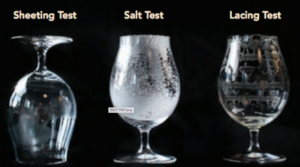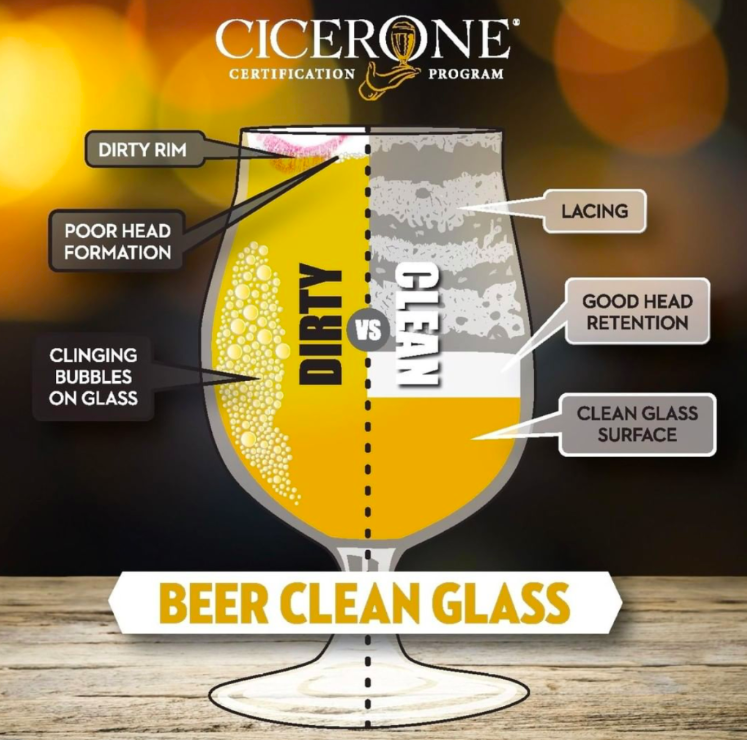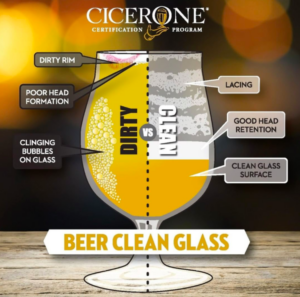Ever ordered a delicious looking beer then noticed the glassware was dirty? It’s the ultimate disappointment. We are here to save the day with the Official Beer Glass Cleaning Guide for your home bar, pub, restaurant, and brewery needs!
Cleaning Beer Glassware
By: Katie Strain, MSU Denver and Nick Harris, Berkeley Yeast
REVIEW PROCEDURE
Having a beer clean glass is the industry standard for pouring a perfect beer. A beer clean glass is free of residue, sanitizer, bacteria, and anything else that CO2 can stick to or generate foul odors in the glass. This results in a well-formed head with good retention, and visual appeal.
INTRODUCTION
The perfect pour starts with clean taps and clean glassware. A spotless beer glass that is devoid of lip gloss and other residue enhances the overall customer experience and ensures that the quality of the beer is preserved. On the other hand, dirty glassware can have a significant and negative impact on the taste, aroma, carbonation level, and appearance of the beer, which is almost certain to influence the customer’s perception of both the brewery that produced the beer and the bar establishment.
Several factors can cause dirty glassware. The most common culprit is poor washing technique. Inadequate washing, rinsing, or using an ineffective detergent can lead to the deposition of greasy or soapy films, mineral deposits, or even bacteria. Any residual grease or soap will be sure to kill head retention and can also cause bubbles to form on the sides of the glass, which can change the mouthfeel and give the beer an unpleasant appearance. In some cases where glassware is not properly cleaned or dried, an intense and unpleasant “wet dog” aroma can overwhelm the beer and ruin the beer drinking experience. Additionally, improper storage of glassware can cause small cracks and scratches that provide a rough surface for contaminants to cling to.
It is crucial that bar establishments have stringent cleaning, handling, and storage procedures in place to maintain clean glassware. The following section details best practices to ensure every pour tastes and looks as good as possible.
HEALTH AND SAFETY
Glassware cleaners may cause skin and eye irritation. Use caution when adding detergent and sanitizer to sinks, and wear gloves and safety glasses where necessary. Employees should read and be familiar with Safety Data Sheets (SDS) for chemicals before use.
MATERIALS
Open drain for emptying used glassware
3-compartment stainless steel sink or automatic dishwasher dedicated to beer glassware
Manual or electric glass washing brush
Non-petroleum based, low-suds glass washing detergent
Overflow tube
Glassware sanitizer
Perforated drainage rack
PROCEDURE
Tips: To maintain beer-clean glassware, it is best to designate other glassware for drinks containing dairy, soft drinks, or juice. Also, do not use a bar towel to dry any glassware. Finally, store glassware in a clean area, away from grease, dust, or heavy odors.
Cleaning glassware using the three-sink method:
Clean stainless steel sink with some bar glass cleaner and a clean brush. If using electric brushes, remove those before cleaning the sink, then replace once finished.
Fill sink with hot water almost to the top of the brushes.
If your establishment has hard water, add mineral solvents to help prevent spotting
Add the proper amount of glass cleaner to the first compartment
Use an overflow tube and fill second compartment with cool, running water.
Fill third compartment with water that is in the appropriate temperature range for your chosen sanitizer. Add the sanitizer to reach the proper final concentration.
Empty the used dirty glass into an open drain that is adjacent to the 3-compartment sink.
Wash the glass in the first sink, making sure all parts of the glass come into contact with the brushes, including the outside of the glass. If using a 3-brush system, clean with the center brush.
Rinse the glass in the second sink, heel-in, heel-out. This means that you put the glass into the sink right-side-up so that water flows into the glass, then tip the glass up-side down to dump water back into the sink.
Rinse the glass in the third, sanitizer sink, following the heel-in, heel-out procedure.
Place the glass upside down on a drainage rack that allows for air flow in and around the glass.
Cleaning glassware in an automatic dishwasher:
This machine should be dedicated to beer glassware only. Never use this machine to wash dishes containing grease, oils, eggs, or dairy, as these residues could contaminate beer glassware.
Use detergent, sanitizer, and rinse-aid that is designed for washing glassware.
Water temperature should range between 130-140°F.
High-temperature dishwashers that operate at 180°F may be used in liu of chemical sanitizers.
Automatic dishwashers should be serviced and cleaned regularly.
Empty glass into an open drain.
Place glass upside down on a dishwasher rack.
Run the cycle according to the manufacturer’s instructions.
After the cycle, dry the glass upside down on a rack so that air can circulate inside and around the glass.
Checking to see if your glassware is ‘beer-clean’:
Sheeting Test
Fill glass with water, then observe the water and glass as you dump the water out:
If the water sheets off evenly, the glass is beer-clean.
If the water breaks into droplets or webs, the glass is dirty.
Salt Test
Sprinkle salt inside a wet glass.
Check to see how the salt coats the glass:
If the salt coats the glass evenly, the glass is beer-clean.
If the salt doesn’t stick to certain spots on the glass, the glass is dirty.
Lacing Test
Fill a glass with beer. Take note of head size, shape, and retention. Bubbles clinging to the side of the glass within the beer (not head) level, indicates the glass is dirty.
Pour some beer out and let the foam settle so that you can monitor lacing:
If the foam creates parallel rings, the glass is beer-clean.
If the foam has a random pattern, or no pattern at all, the glass is dirty.

https://www.mainstreetbev.com/glassware
REFERENCES
Cicerone Certification Program, Version 5.0- April 1, 2022., Certified Beer Server Syllabus.
WebstaurantStore. How to Clean Beer Glasses. Accessed 4/18/2023.
Download
The Official Beer Glass Cleaning Guide
Want to learn more about keeping your entire setup squeaky clean?
Check out our Beer Faucet cleaning guide here!









